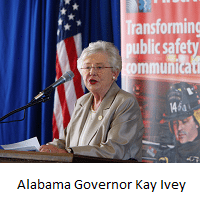
The decision makes Alabama the 24th state to opt-in to FirstNet. “From volunteer emergency responders in our rural communities to those on the front lines in more populated areas, our public safety community deserves access to the tools they need most. This collaboration with FirstNet and AT&T will allow us to provide our first responders increased capabilities to communicate as effectively and efficiently as possible, while also ensuring that our residents and businesses have the best possible services provided to them in times of emergency,” Ivey stated.
Following an evaluation of the proposed AT&T and FirstNet plan, as well as proposals by other potential vendors, Alabama selected the FirstNet and AT&T public-private partnership to transform the way Alabama’s firefighters, police, emergency medical services and other public safety personnel communicate and share information.
The Alabama First Responder Wireless Commission (AFRWC) comprised of multiple state, local, and tribal public safety organizations and professional associations, on September 21, voted unanimously in a special-called meeting to send an “opt-in” letter of recommendation to Governor Ivey, according to the press release. Working with AFRWC, FirstNet and AT&T crafted a plan to meet Alabama’s unique communications needs, including expanding rural coverage beyond what is currently available from commercial carriers, offering affordable data services to public safety across the state and delivering a network for public safety with continuing expansive geographical coverage and increasing redundancy and resiliency.
Preemption for primary users over the AT&T LTE network is expected by year-end, Inside Towers reported. This means first responder subscribers, including fire and rescue services, law enforcement, emergency medical services, emergency management and 9-1-1 personnel, will have dedicated access to the network when and where they need it – 24/7/365.
October 12, 2017




Reader Interactions